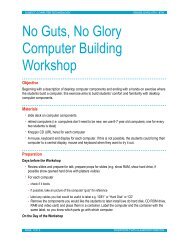Workshop Report - Pervasive Technology Institute - Indiana University
Workshop Report - Pervasive Technology Institute - Indiana University
Workshop Report - Pervasive Technology Institute - Indiana University
Create successful ePaper yourself
Turn your PDF publications into a flip-book with our unique Google optimized e-Paper software.
<strong>Workshop</strong> participants and members of the public were invited to submit white papers for<br />
consideration by workshop participants. Four white papers were submitted, which are included here<br />
in their entirety.<br />
Appendix 2.1. Bridging Resources Using Lustre as a Wide Area<br />
Filesystem<br />
Stephen Simms, <strong>Indiana</strong> <strong>University</strong><br />
Difficulties with data movement between resources and data management across administrative<br />
domains can create barriers for the process of scientific discovery. <strong>Indiana</strong> Universtity believes that<br />
the use of a wide area filesystem can be a very effective way to facilitate data sharing across distance<br />
and enable workflows spanning geographically distributed resources. The goal of this paper is to<br />
provide a few examples of how <strong>Indiana</strong> <strong>University</strong> has used the Lustre filesystem to span a single<br />
campus and bridge multiple campuses.<br />
In 2005 the NSF granted $1.72 million to <strong>Indiana</strong> <strong>University</strong> for the construction of a storage<br />
facility, which we called the Data Capacitor. The goal of the system was to provide users with a<br />
high speed, high capacity filesystem for the short to mid-term storage of large research data sets. We<br />
chose the parallel distributed Lustre filesystem because of its scalability, speed, and ability to serve<br />
many clients. The Data Capacitor sits at the center of IU’s cyberinfrastructure where it participates<br />
in all phases of the data lifecycle. As part of the grant we constructed 10Gb pipes to campus<br />
laboratories in order to permit a fast path between instruments and the Data Capacitor filesystem.<br />
We created a bridge between those campus resources and local cyberinfrastructure. At the same<br />
Figure 1. Data Capacitor spanning campus resources<br />
38






